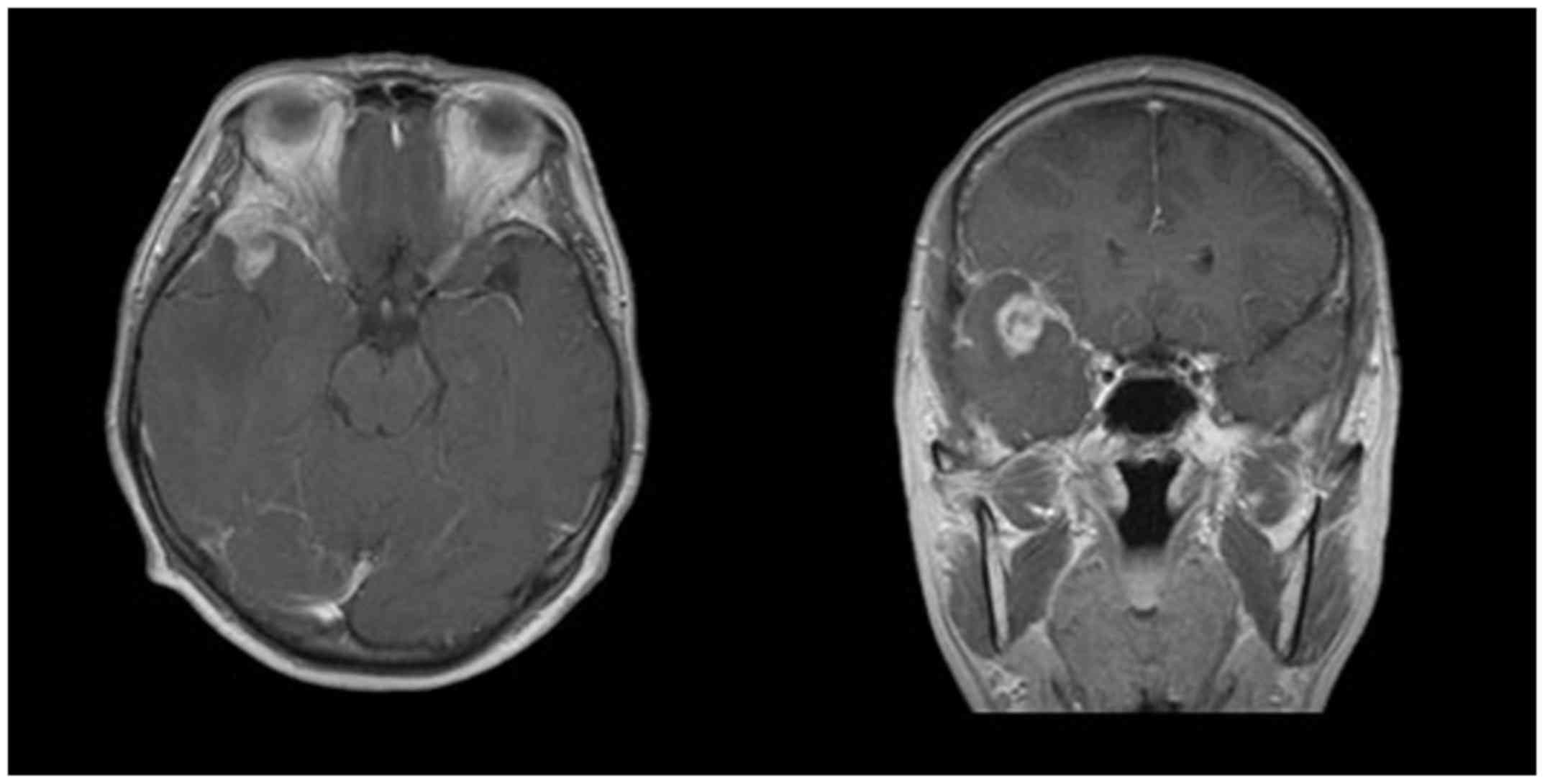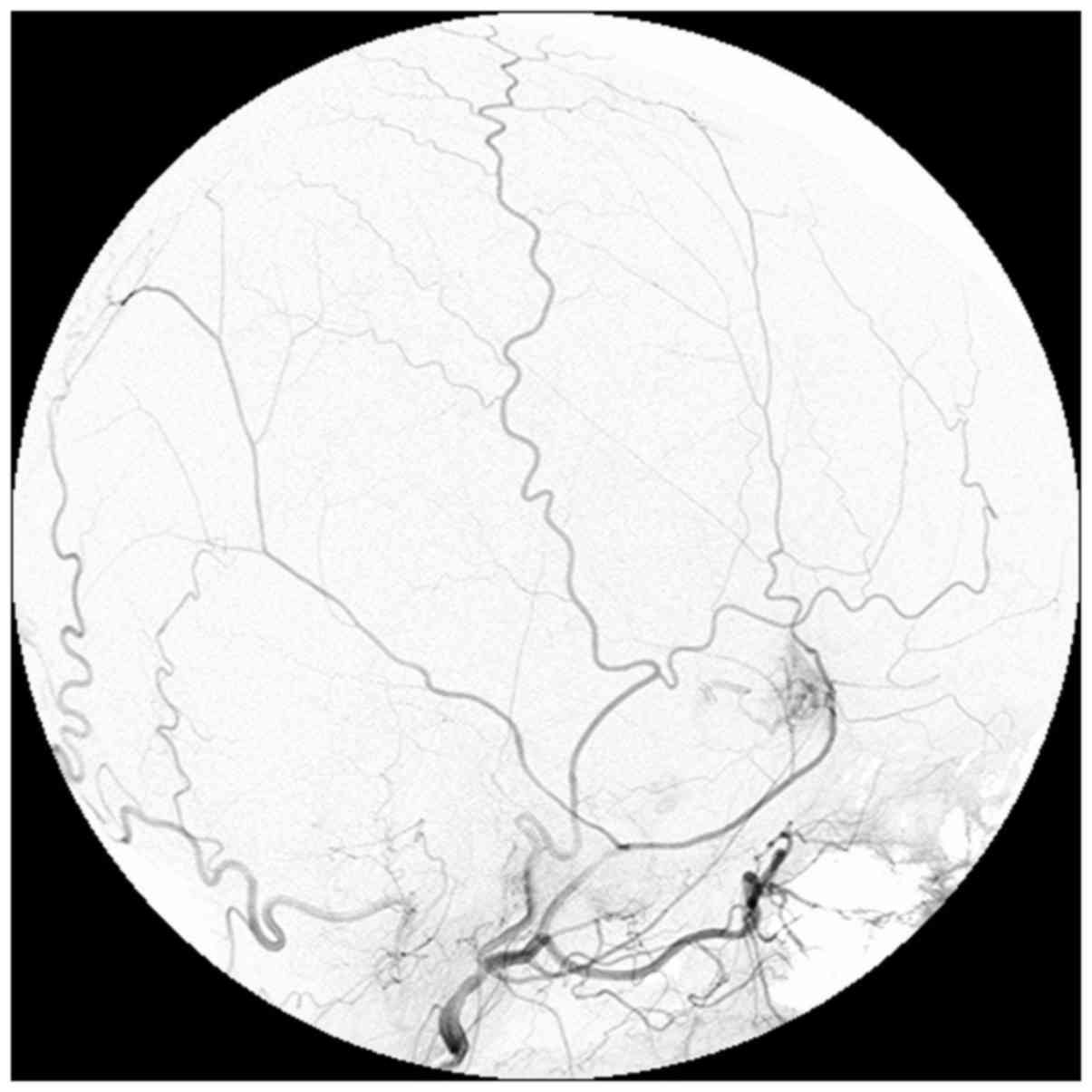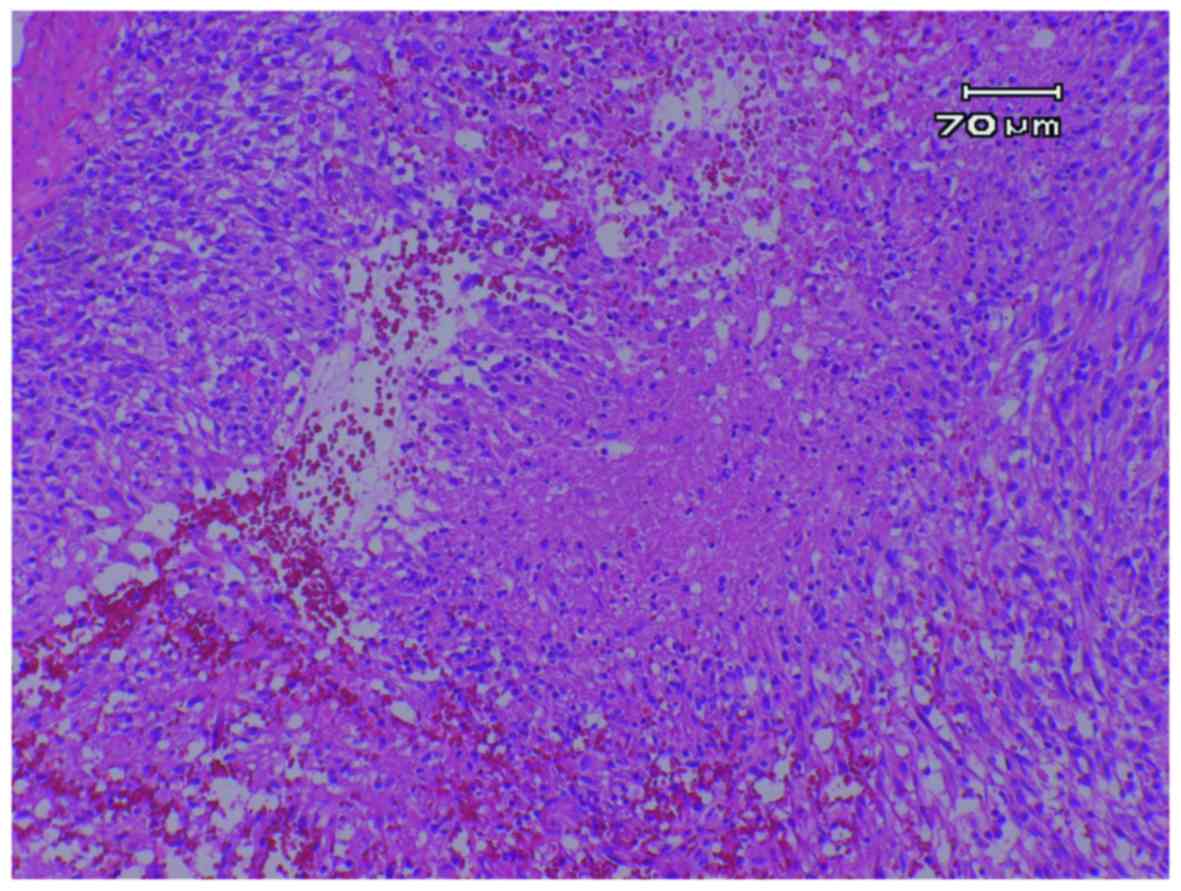Solitary primary intracranial leptomeningeal glioblastoma invading the normal cortex: Case report
- Authors:
- Takamichi Katsuhara
- Nobuhiro Moro
- Takashi Ohta
- Taku Homma
- Atsuo Yoshino
View Affiliations
Affiliations: Department of Neurological Surgery, Nihon University School of Medicine, Tokyo 173-8610, Japan, Department of Pathology, Nihon University School of Medicine, Tokyo 173-8610, Japan
- Published online on: January 25, 2018 https://doi.org/10.3892/mco.2018.1561
-
Pages:
466-470
Metrics: Total
Views: 0 (Spandidos Publications: | PMC Statistics: )
Metrics: Total PDF Downloads: 0 (Spandidos Publications: | PMC Statistics: )
This article is mentioned in:
Abstract
Solitary primary intracranial leptomeningeal glioma (PLG) is a rare entity of glioma. PLG arises from the heterotopic glial tissue in the subarachnoid space and usually grows there without parenchymal invasion. The present study reported a case of solitary PLG, pathologically diagnosed as glioblastoma, that invaded the temporal cortex and finally disseminated to the spinal cord. A 55-year-old woman had headaches and visited Nihon University, Itabashi Hospital. Head magnetic resonance imaging showed a solid mass mainly located in the right middle fossa extending to the frontal base with strong enhancement effect after contrast medium injection. A conventional angiogram showed a tumor arising from the middle meningeal artery. Fronto-temporal craniotomy was performed to remove the tumor. During reflection of the dura matter, there were numerous small vessels connecting the dura matter and the cortical surface. The tumor was located in the Sylvian fissure and extended around the middle cerebral artery. The border between the tumor and the normal temporal lobe was unclear. Temporal lobectomy was done, but the tumor was left around the perforators of the middle cerebral artery. Hematoxylin and eosin staining showed typical glioblastoma with high cellularity, mitosis, pseudopallisading and vascular proliferation. The tumor cells were immunohistochemically negative for isocitrate dehydrogenase (IDH)1-R132H indicating glioblastoma, IDH-wild type. The patient received chemotherapy and radiation therapy, and was discharged from the hospital. Six months later, local regrowth and spinal dissemination were found. Despite additional chemotherapy and radiation therapy, the tumor became uncontrollable and the patient succumbed. Only 15 cases of solitary PLGs have been reported previously. The IDH status of these tumors have not been investigated in most cases; however, pathological grading varies from lower to higher grade glioma. Together with the pathological difference of astrocytic or oligodendrocytic tumors, solitary PLGs may develop due to various gene alterations similar to intra-axial gliomas.
View References
|
1
|
Wolbach SB: Congenital Rhabdomyoma of the
Heart. J Med Res. 16:495–520.7. 1907.PubMed/NCBI
|
|
2
|
Krief O, Monnier L, Cornu P, Foncin JF,
Dormont D and Marsault C: MR of isolated leptomeningeal glioma.
AJNR Am J Neuroradiol. 15:1782–1784. 1994.PubMed/NCBI
|
|
3
|
Wakabayashi K, Shimura T, Mizutani N,
Koide A, Yamagiwa O, Mori F, Nishiyama K, Tanaka R and Takahashi H:
Primary intracranial solitary leptomeningeal glioma: A report of 3
cases. Clin Neuropathol. 21:206–213. 2002.PubMed/NCBI
|
|
4
|
Horoupian DS, Lax F and Suzuki K:
Extracerebral leptomeningeal astrocytoma mimicking a meningioma.
Arch Pathol Lab Med. 103:676–679. 1979.PubMed/NCBI
|
|
5
|
Shuangshoti S, Kasantikul V, Suwanwela N
and Suwanwela C: Solitary primary intracranial extracerebral
glioma. Case report. J Neurosurg. 61:777–781. 1984. View Article : Google Scholar : PubMed/NCBI
|
|
6
|
Sceats DJ Jr, Quisling R, Rhoton AL Jr,
Ballinger WE and Ryan P: Primary leptomeningeal glioma mimicking an
acoustic neuroma: Case report with review of the literature.
Neurosurgery. 19:649–654. 1986. View Article : Google Scholar : PubMed/NCBI
|
|
7
|
Kakita A, Wakabayashi K, Takahashi H,
Ohama E, Ikuta F and Tokiguchi S: Primary leptomeningeal glioma:
Ultrastructural and laminin immunohistochemical studies. Acta
Neuropathol. 83:538–542. 1992. View Article : Google Scholar : PubMed/NCBI
|
|
8
|
Oka H, Kawano N, Morii S, Suwa T, Irikura
K and Saitoh T: Intracranial extracerebral glioma]. Noshuyo Byori
11: 193–200, 1994. Noshuyo Byori. 11:193–200. 1994.(In
Japanese).
|
|
9
|
Opeskin K, Anderson RM and Nye DH: Primary
meningeal glioma. Pathology. 26:72–74. 1994. View Article : Google Scholar : PubMed/NCBI
|
|
10
|
Ng HK and Poon WS: Primary leptomeningeal
astrocytoma. Case report. J Neurosurg. 88:586–589. 1998. View Article : Google Scholar : PubMed/NCBI
|
|
11
|
Sell M, Mitrovics T and Sander BC: Primary
nodular meningeal glioma mimicking metastatic tumor of the
cerebellum with diffuse infra- and supratentorial leptomeningeal
spread. Clin Neuropathol. 19:126–130. 2000.PubMed/NCBI
|
|
12
|
Cirak B, Caksen H, Ugras S and Unal O:
Primary leptomeningeal astrocytoma in a child. Pediatr Int.
42:389–391. 2000. View Article : Google Scholar : PubMed/NCBI
|
|
13
|
De Tommasi A, Occhiogrosso G, De Tommasi
C, Luzzi S, Cimmino A and Ciappetta P: A polycystic variant of a
primary intracranial leptomeningeal astrocytoma: Case report and
literature review. World J Surg Oncol. 5:722007. View Article : Google Scholar : PubMed/NCBI
|
|
14
|
Kim YG, Kim EH, Kim SH and Chang JH:
Solitary primary leptomeningeal glioma: Case report. Brain Tumor
Res Treat. 1:36–41. 2013. View Article : Google Scholar : PubMed/NCBI
|
|
15
|
Bailey P and Robitaille Y: Primary diffuse
leptomeningeal gliomatosis. Can J Neurol Sci. 12:278–281. 1985.
View Article : Google Scholar : PubMed/NCBI
|
|
16
|
Cooper IS and Kernohan JW: Heterotopic
glial nests in the subarachnoid space; histopathologic
characteristics, mode of origin and relation to meningeal gliomas.
J Neuropathol Exp Neurol. 10:16–29. 1951. View Article : Google Scholar : PubMed/NCBI
|












